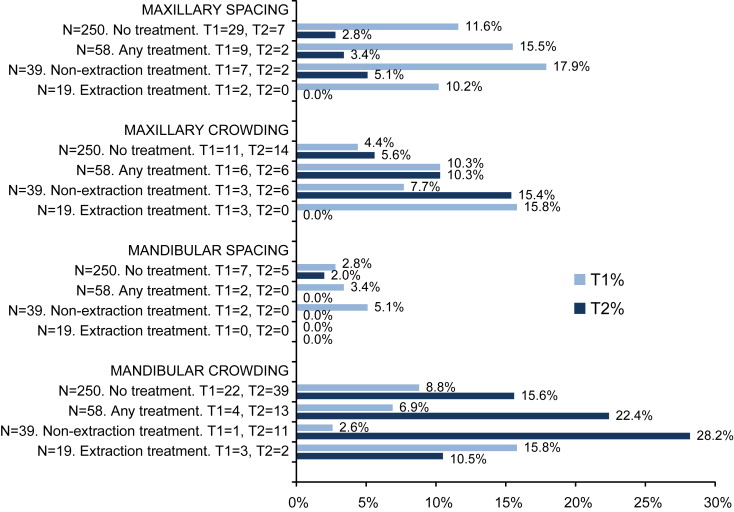Introduction
The purposes of this study were to analyze long-term changes in anterior spacing and crowding and to compare the development in orthodontically treated and untreated subjects.
Methods
The sample comprised 308 adolescents in the late mixed or early permanent dentition who were examined clinically at the ages of 7 to 17 years and again 25 years later. The treated subgroup of 58 subjects had received orthodontic treatment with fixed or removable appliances or both. All subjects had a full complement of teeth, except for 19 who had premolar extractions as part of their orthodontic treatment plan.
Results
The prevalence of maxillary anterior spacing was substantially and significantly reduced in both the untreated and treated groups from the first examination to the second. The prevalence of mandibular crowding increased significantly in the untreated and the nonextraction treated groups. The prevalence of mandibular crowding in patients treated without extractions increased by 25.6%, significantly more than in the untreated controls. The prevalence of maxillary crowding decreased by 15.8% in patients treated with maxillary premolar extractions, significantly more than in the untreated controls.
Conclusions
Long-lasting developmental factors seem to result in universally reduced maxillary anterior spacing, orthodontic treatment notwithstanding. Compared with untreated subjects, the long-term development of mandibular anterior crowding was unfavorable in subjects treated without extractions. Compared with untreated subjects, the long-term development of maxillary anterior crowding was favorable when treatment included extraction of the maxillary premolars.
Editor’s comment
When you meet with a prospective patient to discuss the benefits of orthodontic treatment, do you try to support your advice with either sound experience or high-level evidence? What do you say if there is limited evidence? Will crowding continue to worsen with no treatment? Or does orthodontic treatment lead to fewer crowding problems in the long term? The purposes of this study were to analyze the long-term changes in people with anterior spacing and crowding and to compare their development in orthodontically treated and untreated subjects.
The original sample of randomly selected subjects comprised 1641 primary schoolchildren in Reykjavík, Iceland, examined clinically at the ages of 7-17 years. This study was based on 832 subjects (50.7%) from this sample who were available for a second examination 25 years later. The untreated control group comprised 250 subjects with complete dentitions at both examinations.
The treated sample of 58 subjects was divided into subgroups: 39 were treated without extractions, and 19 were treated orthodontically with premolar extractions.
In the developing dentition, available space in the anterior region is at a minimum. But in subsequent phases of eruption, differences in the sizes of deciduous and permanent teeth, called leeway space, will alleviate anterior crowding temporarily. The counteracting forces will, however, prevail and eventually shorten the arches and cause anterior dental crowding. In this long-term follow up, the active skeletal and dental changes seen during adolescence gave way to more gradual adjustments during adulthood. The details of these patients’ occlusal examinations 25 years later is fascinating, and you will want to read this entire article online. Perhaps the most intriguing result is the long-term status of mandibular anterior crowding in subjects who were treated nonextraction. The return of their crowding was significantly worse than that observed in the untreated subjects. I seriously doubt that this is what the unsuspecting patient had in mind 25 years earlier when deciding to accept the doctor’s plan of treatment.





